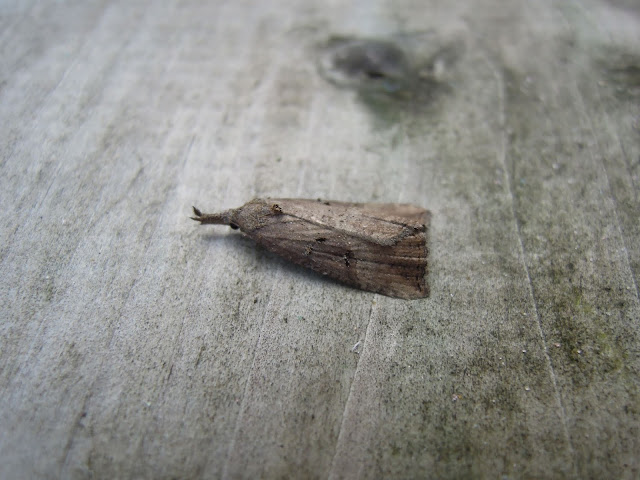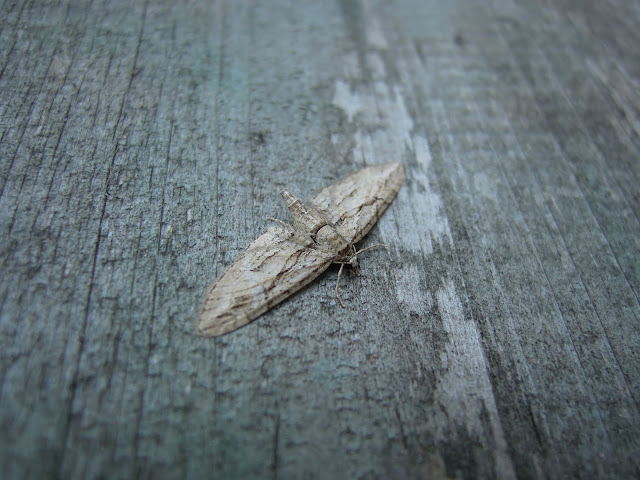Monday, 31 December 2018
Monday, 15 October 2018
13th October 2018
After trapping the previous night where there were strong gusts, the continued mild overnight temperatures (and lighter winds)convinced me that I should try again. I was glad that I did despite torrential downpours when opening up the trap...three new species for the garden is rather unexpected in mid October. Overall, c.115 moths of 34 species was an almost unprecedented return for this time of year.
[485] Rhomboid Tortrix
[486] Olive-tree Pearl
[487] Brindled Green
The clear headliner was the Olive-tree Pearl (Palpita vitrealis) which is a scarce migrant nationally with only a handful of Cambridgeshire records. It was the last moth located in the trap and nearly escaped my clutches.
A couple of Acleris type tortrix had me stumped for a while - they are somewhat different to each other but both are clearly the the rather variable Rhomboid Tortrix. A supposedly common species that wasn't really on my radar - wonder if I've overlooked them previously?
Brindled Green is normally noted as a common moth in the autumn but doesn't appear to be so here. This is just my second record in the village with the previous one being in late September 2018.
Amongst many other autumn species there were seven Green-brindled Crescent which is by far the most I've caught in one night. Both forms (standard and the melanic f. capucina) were represented:
[485] Rhomboid Tortrix
[486] Olive-tree Pearl
[487] Brindled Green
The clear headliner was the Olive-tree Pearl (Palpita vitrealis) which is a scarce migrant nationally with only a handful of Cambridgeshire records. It was the last moth located in the trap and nearly escaped my clutches.
 |
| Olive-tree Pearl Palpita vitrealis |
 |
| Rhomboid Tortrix Acleris rhombana |
 |
| Brindled Green Dryobotodes eremita |
Amongst many other autumn species there were seven Green-brindled Crescent which is by far the most I've caught in one night. Both forms (standard and the melanic f. capucina) were represented:
 |
| Green-brindled Crescent Allophyes oxyacanthae |
Tuesday, 9 October 2018
Monday, 1 October 2018
Wednesday, 19 September 2018
16th September 2018
A mild night brought some good moths in again, with four new for the garden:
[479] Dioryctria sylvestrella
[480] Toadflax Brocade
[481] Pink-barred Sallow
[482] Dark Spectacle
The Dioryctria pyralids are rather tricky but the one caught looks good for the largest of the group, D.sylvestrella (AKA New Pine Knot-horn) rather than abietella which I trapped over the summer:
It was good to reacquaint myself with Toadflax Brocade - just my second record in the village with the previous being August 2015. There is a large stand of the food plant not too far away so its no real surprise that its turned up in the High St garden.
Pink-barred Sallow is surprisingly scarce here it seems - on checking my records this is my only third ever record in Cottenham. It's probably the sharpest of the sallows:
Dark Spectacle isn't too common either, I haven't picked one up since 2013:
Plenty of other moths were in the trap with Square-spot Rustic being ubiquitous at this time of year:
While Gold Triangle is still on the wing:
[479] Dioryctria sylvestrella
[480] Toadflax Brocade
[481] Pink-barred Sallow
[482] Dark Spectacle
The Dioryctria pyralids are rather tricky but the one caught looks good for the largest of the group, D.sylvestrella (AKA New Pine Knot-horn) rather than abietella which I trapped over the summer:
 |
| Dioryctria sylvestrella |
 |
| Toadflax Brocade Calophasia lunula |
Pink-barred Sallow is surprisingly scarce here it seems - on checking my records this is my only third ever record in Cottenham. It's probably the sharpest of the sallows:
 |
| Pink-barred Sallow Xanthia togata |
Dark Spectacle isn't too common either, I haven't picked one up since 2013:
 |
| Dark Spectacle Abrostola triplasia |
Plenty of other moths were in the trap with Square-spot Rustic being ubiquitous at this time of year:
 |
| Square-spot Rustic Xestia xanthographa |
While Gold Triangle is still on the wing:
 |
| Gold Triangle Hypsopygia costalis |
Friday, 14 September 2018
10th September 2018
It's officially autumn judging by the appearance of some classic species from this time of year in the trap. There were also a couple of long awaited firsts for the garden:
[477] Centre-barred Sallow
[478] Small Ranunculus
I was surprised to find that I haven't picked up Centre-barred Sallow since 2013, when I had nine individuals in my Corbett Street trap in late August / Early September. It was annual in years before that too.
This is the first Small Ranunculus I've recorded since 2014 - and the first time I have trapped both Small and Large Ranunculus together:
[477] Centre-barred Sallow
[478] Small Ranunculus
I was surprised to find that I haven't picked up Centre-barred Sallow since 2013, when I had nine individuals in my Corbett Street trap in late August / Early September. It was annual in years before that too.
 |
| Centre-barred Sallow Atethmia centrago |
This is the first Small Ranunculus I've recorded since 2014 - and the first time I have trapped both Small and Large Ranunculus together:
 |
| Small Ranunculus Hecatera dysodea |
Tuesday, 28 August 2018
26th August 2018
One of my most wanted micros finally turned up, the exquisitely marked Ypsolopha sequella (AKA Pied Smudge)
[476] Ypsolopha sequella
Mid to late August normally coincides with a dramatic loss in diversity of catches and so it transpired with less than 35 species recorded. There are plenty of individual moths about though, it is just dominated by a handful of species such as:
[476] Ypsolopha sequella
 |
 |
| Large Yellow Underwing Noctua pronuba |
 |
| Setaceous Hebrew Character Xestia c-nigrum |
 |
| Common Wainscot Mythimna pallens |
20th August 2018
Happy to add Large Thorn to the garden list, my first trapped in the village since 2012:
[475] Large Thorn
Just as surprising was a Barred Sallow - a regular enough moth in the autumn but this is incredibly early - my previous early date was 29th September!
Also present was the fairly common Small Dusty Wave, just a species I hadn't bothered to photograph before:
[475] Large Thorn
 |
| Large Thorn Ennomos autumnaria |
 |
| Barred Sallow Xanthia aurago |
 |
| Small Dusty Wave Idaea seriata |
Monday, 20 August 2018
7th August 2018
Three new for the garden this time:
[471] Epermenia falciformis
[472] Epinotia nisella
[473] Tawny-barred Angle
Epermenia falcifoirmis is a good looking micro that seems to be quite local in the region. Its also the second species of this genus recorded this year.
Last year at about this time I recorded some worn Epinotia species that remained unidentified. Two similar moths occurred in this trap, both with a faint chestnut patch on the forewing - so these (and presumably last years) seem good for E. nisella.
No such ID problems with this Tawny-barred Angle that was on the wall next to the trap. Only my second in Cottenham, with the previous record being from July 2015:
The other highlight was my second ever Oak Nycteoline and the first to stick around for a photo:
[471] Epermenia falciformis
[472] Epinotia nisella
[473] Tawny-barred Angle
Epermenia falcifoirmis is a good looking micro that seems to be quite local in the region. Its also the second species of this genus recorded this year.
 |
| Epermenia falciformis |
Last year at about this time I recorded some worn Epinotia species that remained unidentified. Two similar moths occurred in this trap, both with a faint chestnut patch on the forewing - so these (and presumably last years) seem good for E. nisella.
 |
| Epinotia nisella |
No such ID problems with this Tawny-barred Angle that was on the wall next to the trap. Only my second in Cottenham, with the previous record being from July 2015:
 |
| Tawny-barred Angle Macaria liturata |
The other highlight was my second ever Oak Nycteoline and the first to stick around for a photo:
 |
| Oak Nycteoline Nycteola revayana |
Monday, 6 August 2018
3rd August 2018
After a week away not much has changed - the heatwave goes on. Still plenty of moths around but diversity has started to fall as is typical in August. Still some micros of interest including three new:
[468] Stigmella atricapitella
[469] Prays ruficeps
[470] Recurvaria nanella
At least two of these tiny stigmella were present, the second species of this genus I've recorded this year. The black head and white eye caps look a good fit for S. atricapitella (AKA Black-headed Pigmy) although there are similar species:
New for the year was Tawny Speckled Pug which is annual in small numbers:
[468] Stigmella atricapitella
[469] Prays ruficeps
[470] Recurvaria nanella
At least two of these tiny stigmella were present, the second species of this genus I've recorded this year. The black head and white eye caps look a good fit for S. atricapitella (AKA Black-headed Pigmy) although there are similar species:
 |
| Stigmella atricapitella |
 |
| Prays ruficeps |
 |
| Recurvaria nanella |
 |
| Tawny Speckled Pug Eupithecia icterata |
Norfolk Moths July/ August 2018
A couple of trap nights on holiday in north Norfolk with the actinic resulted in a few species I haven't recorded down here:
 |
| Black Arches Lymnatria monacha |
 |
| Rosy Footman Militochrista miniata |
 |
| Agapeta zoegana f.ferrugana |
 |
| Rosy Minor Litoligia literosa |
 |
| Caryocolum fraternella (assumed) |
 |
| Barred Hook-tip Watsonalla cultaria |
 |
| Dioryctria sylvestrella |
 |
| Dioryctria simplicella |
 |
| Scalloped Hook-tip Falcaria lacertinaria |
 |
| Lathronympha strigana |
 |
| Eudemis profundana |
Subscribe to:
Comments (Atom)












